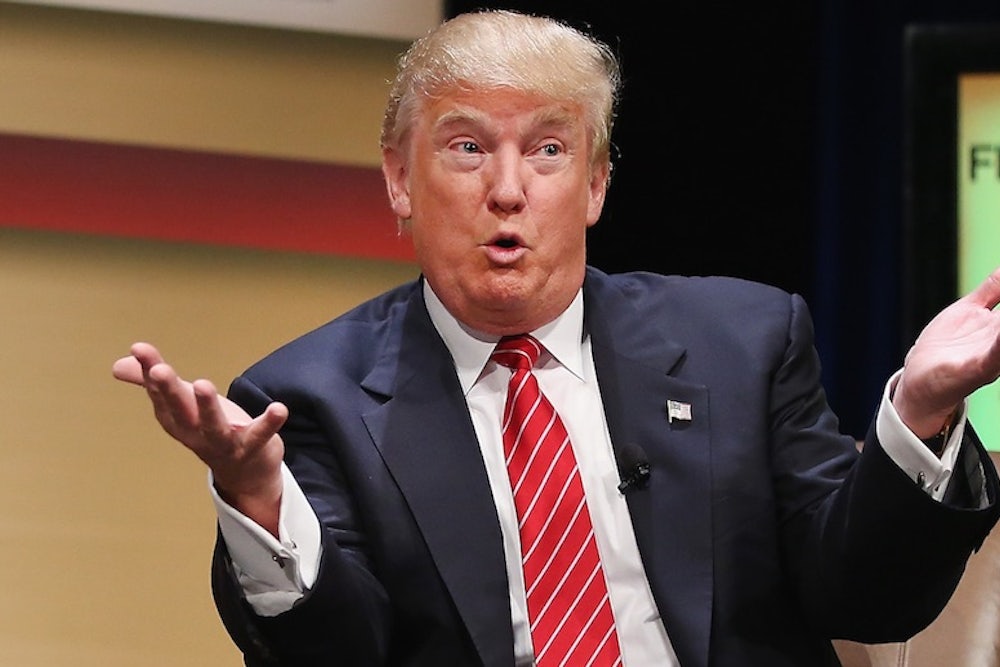Coming out of last weekend, depending on the polling average you prefer, Donald Trump is in first or second in the race for the Republican presidential nomination. The media has drooled over—and enabled—him with saturation coverage, and he is “essentially guaranteed” a spot in next month's debate. On Saturday he said that Senator John McCain is “not a war hero”; time will tell whether this reverses his trajectory or is part of his appeal. But when it comes to being taken as a first-tier candidate, he shouldn’t have gotten even this far. Single-choice, horserace polls provide the wrong kind of data, and it’s misleading much of the media and the public—not to mention Trump himself.
This is not the first time a small surge in support has led to a burst of media coverage. During the 2012 primaries, five GOP candidates had support of at least 20 percent at one point or another: Herman Cain, Newt Gingrich, Rick Perry, Michele Bachmann, and the eventual nominee, Mitt Romney. With 15 GOP candidates in the race this year—and on Tuesday, Ohio Governor John Kasich will make it 16—rankings in a single-choice poll can be swayed by a tiny shift in public opinion. Conventional polls by themselves do not predict whether Trump will survive, like Romney did, or fizzle out after a few months like the others. Horserace polls also do not identify fringe candidates who are unlikely to survive the primary process.
There’s a way to clarify this mess immediately—an innovative technique that would determine who the true frontrunners are, and perhaps even save the GOP debates from becoming a chaotic circus or a ten-part infomercial.
The technique is called instant runoff, and here’s how it works: Ask respondents to rank all of the candidates, from most preferred to least. Pollsters then eliminate the candidate receiving the fewest first votes, and the loser’s supporters are reassigned to their next choice. This process is repeated until there is only one winner left. For example, in a three-way race, supporters of the third-place finisher would have their votes reassigned to the other two candidates.
Instant runoff isn’t theoretical: It’s used in voting around the world, from state and local elections in the U.S. to national elections in countries like India, Australia, and Ireland. At Princeton University, where I teach, faculty members often face ballots with over a dozen candidates for university-wide committees. We use instant-runoff voting to elect the most acceptable—and also least-objectionable—candidate.
On August 6, Fox News will host the first Republican debate, which will feature the top ten candidates in an average of the last five national polls. Such a crowded stage ensures anything but a constructive political debate. Instant runoff can help sort the wheat from the chaff, generating a list of the four or five candidates most likely to survive the primaries. In debates and on the campaign trail, these true top candidates would get the close scrutiny that they deserve.
In a conventional poll, Trump can vault into the top position with an aggressive appeal to nativists, much as a radio talk show host succeeds by commanding a dedicated faction. In contrast, instant-runoff polls would highlight Trump’s very low ceiling of support. In a recent national survey by YouGov, 43 percent of GOP voters view Trump unfavorably. In an NBC/Wall Street Journal poll, 66 percent of Republicans could not see themselves supporting Trump. (For comparison, during the 2012 campaign, up to the time their candidacies flamed out, Cain, Gingrich, and Perry had unfavorable numbers that increased over time, ending up at 30 to 40 percent.) Trump has worse unfavorables than any presidential candidate since 1980. With numbers like these, it is basically impossible for Trump to win a majority of Republican votes.
At the other end of the range, Senator Marco Rubio, Governor Scott Walker, and Ben Carson currently have the highest ceilings of support: They are viewed unfavorably or as unsupportable by an average of less than 20 percent in PPP, YouGov and Wall Street Journal data. Jeb Bush has higher unfavorables, although he has been improving, just as Mitt Romney did in the 2012 primary season. All of these candidates have a more plausible shot at the nomination than Trump.
Some pollsters have taken a baby step in the direction of instant-runoff polls by asking voters for their second choice, providing a clue about who benefits as the field narrows. Using this information, I came up with a simple measure of candidates’ hidden support: a “second-choice ratio,” defined as the number of second-preference responses divided by first-preference responses. Among candidates who are the first choice of at least 5 percent of voters, Rubio's median second-choice ratio is 1.1, suggesting the most potential for future growth. Behind Rubio are Huckabee, at 0.9; Jeb Bush, Ben Carson, and Rand Paul at 0.8; and Scott Walker at 0.7. Trump brings up the rear at 0.6, suggesting that he has few additional lurking supporters, and is close to maxed out.
So is Trump doomed? Probably, but one loophole remains. Starting late in the primary season, over a dozen states have winner-take-all primaries, where finishing first is enough to win delegates. If not enough candidates drop out by then, Trump could conceivably end up with some representation. That could lead to an exceptionally lively convention—and perhaps a groundswell of support, not only for instant-runoff polling, but for instant-runoff voting in the 2020 Republican primaries.
